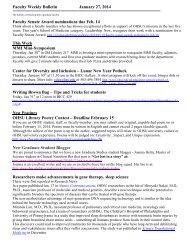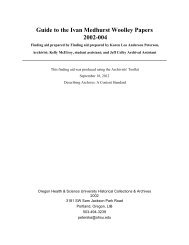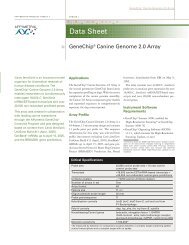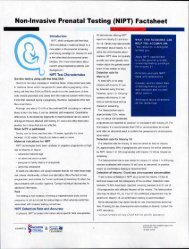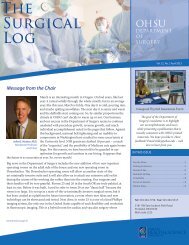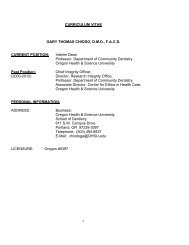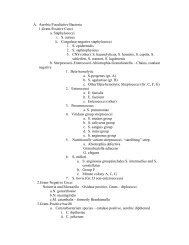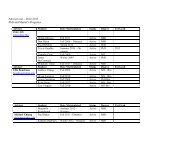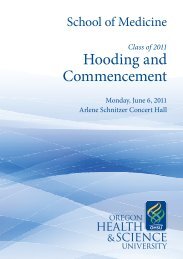Lentiviral Vectors: design, production, and titration
Lentiviral Vectors: design, production, and titration
Lentiviral Vectors: design, production, and titration
Create successful ePaper yourself
Turn your PDF publications into a flip-book with our unique Google optimized e-Paper software.
<strong>Lentiviral</strong> <strong>Vectors</strong>:<br />
<strong>design</strong>, <strong>production</strong>,<br />
<strong>and</strong> <strong>titration</strong><br />
ONPRC <strong>Lentiviral</strong> Vector Core<br />
Molecular <strong>and</strong> Cellular Biology Core<br />
Greg Dissen
HIV provirus<br />
LTR<br />
ψ SD<br />
∆<br />
Gag<br />
Pro<br />
Pol<br />
∆<br />
Vif<br />
R<br />
U<br />
Tat<br />
Rev<br />
Env<br />
RRE<br />
2 nd <strong>and</strong> 3 rd generation viral vectors<br />
1. Viral backbone was stripped to allow room for transgenes<br />
2. Development of the Self-Inactivating (SIN) vector<br />
Nef<br />
∆<br />
LTR
<strong>Lentiviral</strong> Vector System<br />
2. Modification of 3’LTR “Self Inactivating”<br />
-456 +1 +60 +181<br />
U3 R U5<br />
-418<br />
EcoRV<br />
AP-1<br />
NF-AT?<br />
USF NF-κB<br />
Ets NF-ATc<br />
TCF-1α<br />
400 bp Deletion<br />
SP1<br />
TATA<br />
-18<br />
PvuII<br />
Wild-Type HIV 3’ LTR<br />
∆U3 R U5<br />
pHR’ SIN-18
<strong>Lentiviral</strong> Vector System (3 rd generation)<br />
5’LTR Ψ SD RRE cPPT hCMV-P eGFP wPRE SIN3’LTR<br />
DU3 R U5<br />
∆U3 R U5<br />
Self Inactivation<br />
No LTR promoter interference<br />
Integration into the<br />
Host Genome<br />
∆U3 R U5<br />
∆U3 R U5
HIV provirus<br />
LTR<br />
ψ SD<br />
Gag<br />
Pro<br />
2 nd Generation vector<br />
DU3 R U5<br />
RSV<br />
DU3 R U5<br />
Pol<br />
Vif<br />
R<br />
U<br />
Tat<br />
Rev<br />
Env<br />
<strong>Lentiviral</strong> Vector Systems<br />
Requires Tat for <strong>production</strong><br />
3rd Generation vector<br />
Constitutive promoter<br />
RSV or CMV<br />
Tat is not required<br />
RRE<br />
Nef<br />
∆<br />
LTR<br />
SIN<br />
∆U3 R U5<br />
SIN<br />
∆U3 R U5
<strong>Lentiviral</strong> Vector Generations<br />
HIV provirus: provirus<br />
LTR<br />
SD ψ<br />
Gag<br />
1 st Generation:<br />
HIV-1 core proteins<br />
Enzymes <strong>and</strong><br />
Accessory factors<br />
From separate plasmid<br />
And env plasmid<br />
2 nd Generation:<br />
Packaging reduced<br />
gag, pol, tat, rev<br />
And env plasmid<br />
3 rd Generation:<br />
Requirement for tat<br />
Eliminated, rev<br />
Moved to separate<br />
plasmid<br />
Pro<br />
pLV<br />
pMD.G +<br />
pLV<br />
pMD.G<br />
pLV<br />
pMD.G<br />
+<br />
+<br />
Pol<br />
Vif<br />
R<br />
U<br />
Tat<br />
Rev<br />
pRSV-Rev or pLP2<br />
RRE<br />
Env<br />
Nef<br />
LTR<br />
pMDLgpRRE or pLP1
Packaging plasmids<br />
4 th generation?<br />
Clontech
<strong>Lentiviral</strong> Vector Systems<br />
5’LTR Ψ SD RRE cPPT wPRE SIN3’LTR<br />
8 KB<br />
DU3 R U5<br />
3 rd Gen<br />
Constitutive<br />
Promoter:<br />
RSV<br />
CMV<br />
Packaging<br />
Region<br />
Rev<br />
responsive<br />
element<br />
Splice<br />
Donor<br />
Site<br />
central<br />
polypurine<br />
tract<br />
Both cPPT <strong>and</strong> wPRE increase<br />
Transduction efficiency <strong>and</strong> transgene expression<br />
∆U3 R U5<br />
woodchuck<br />
hepatitis virus<br />
posttranscriptional<br />
regulatory<br />
element<br />
pHR’ SIN-18<br />
Rev is essential for viral replication<br />
Binds mRNAs removing them from splicesome = full-length <strong>and</strong> partially spliced
<strong>Lentiviral</strong> Vector Systems<br />
5’LTR Ψ SD RRE cPPT hCMV-P eGFP wPRE SIN3’LTR<br />
DU3 R U5<br />
Reporter Vector<br />
RNA Polymerase II<br />
Constitutive:<br />
CMV<br />
SV40<br />
hEFp<br />
PGK<br />
Tissue Specific<br />
Reporter<br />
∆U3 R U5
<strong>Lentiviral</strong> Vector System (3 rd generation)<br />
5’LTR Ψ SD RRE cPPT hCMV-P eGFP wPRE SIN3’LTR<br />
DU3 R U5<br />
New components:<br />
DU3 R U5<br />
Internal Ribosome Entry Site:<br />
IRES<br />
∆U3 R U5<br />
∆U3 R U5<br />
Allows the <strong>production</strong> of two proteins from one mRNA. A Bicistronic RNA.<br />
DU3 R U5<br />
2 nd<br />
promoter<br />
Allows the <strong>production</strong> of two mRNAs from one vector.<br />
∆U3 R U5
<strong>Lentiviral</strong> Vector System (3 rd generation)<br />
5’LTR Ψ SD RRE cPPT hCMV-P eGFP wPRE SIN3’LTR<br />
DU3 R U5<br />
New components:<br />
DU3 R U5<br />
MCS<br />
IRES<br />
Multiple Cloning Site for transgenes to be expressed:<br />
DU3 R U5<br />
Transgene<br />
2 nd<br />
promoter<br />
IRES<br />
2 nd<br />
promoter<br />
∆U3 R U5<br />
∆U3 R U5<br />
∆U3 R U5
<strong>Lentiviral</strong> Vector System (3 rd generation)<br />
DU3 R U5<br />
Transgene<br />
Insertion of a heterologous Intron<br />
IRES<br />
∆U3 R U5<br />
A heterologous intron had been found to increase expression of transgenes<br />
in transgenic mice.<br />
DU3 R U5<br />
Intron<br />
Transgene<br />
Rat insulin II intron A<br />
2 nd<br />
promoter<br />
∆U3 R U5
<strong>Lentiviral</strong> Vector System (3 rd generation)<br />
DU3 R U5<br />
DU3 R U5<br />
ng/ml medium<br />
200<br />
150<br />
100<br />
50<br />
0<br />
CMV<br />
Intron<br />
LV<br />
NGF<br />
NGF<br />
IRES<br />
IRES<br />
No Intron<br />
Intron<br />
∆U3 R U5<br />
∆U3 R U5<br />
Small peptide<br />
Lig<strong>and</strong> is<br />
Produced <strong>and</strong><br />
Expression is<br />
Enhanced<br />
From vector<br />
Containing<br />
Heterologous<br />
Intron
1<br />
2<br />
3<br />
4<br />
5<br />
DU3 R U5<br />
DU3 R U5<br />
DU3 R U5<br />
DU3 R U5<br />
DU3 R U5<br />
Jag<br />
GAPDH<br />
GFP<br />
<strong>Lentiviral</strong> Vector System (3 rd generation)<br />
CMVp<br />
Intron<br />
Jag<br />
IRES<br />
hEFp<br />
1 2 3 4 5<br />
eGFP<br />
∆U3 R U5<br />
140 kD<br />
42 kD<br />
27 kD<br />
∆U3 R U5<br />
∆U3 R U5<br />
∆U3 R U5<br />
∆U3 R U5
1<br />
2<br />
3<br />
4<br />
5<br />
DU3 R U5<br />
DU3 R U5<br />
DU3 R U5<br />
DU3 R U5<br />
DU3 R U5<br />
Jag<br />
GAPDH<br />
GFP<br />
<strong>Lentiviral</strong> Vector System (3 rd generation)<br />
CMVp<br />
Intron<br />
Jag<br />
IRES<br />
hEFp<br />
1 2 3 4 5<br />
eGFP<br />
∆U3 R U5<br />
∆U3 R U5<br />
∆U3 R U5<br />
∆U3 R U5<br />
∆U3 R U5
FXYD1 EGFP<br />
CMV IRES<br />
CMV<br />
polybrene LV FIG LV GIF<br />
1:10 1:20 1:30 1:10 1:20 1:30<br />
EGFP<br />
IRES<br />
LV FIG (1:30) LV GIF (1:30)<br />
FXYD1<br />
GAPDH (36kDa)<br />
eGFP (27kDa)<br />
FXYD (14kDa)<br />
Infection of Hib5 (6 Well plate, 200,000 cells/well)
<strong>Lentiviral</strong> Vector System: Gene Suppression<br />
pPRIME<br />
Potent RNA Interference<br />
using MicroRNA Expression<br />
pPRIME-CMV-GFP<br />
miR30-shRNA<br />
CMV RRE<br />
GFP 5’miR30<br />
CM R WRE<br />
Pol II driven shRNA<br />
was more active<br />
than the Pol III<br />
construct<br />
cPPT Xho I EcoRI<br />
pPRIME-<br />
TET-GFP<br />
CMV-dsRED<br />
CMV-Neo<br />
T-REX-GFP<br />
miR30=<br />
Retinoblastoma (Rb)<br />
Targeting sequence:<br />
AGCAGTTCGATATCTACTGAAA<br />
DU3 R U5 CMV 3’miR30<br />
∆U3 R U5<br />
Stegmeier, 2005
<strong>Lentiviral</strong> Vector System: Gene Suppression<br />
5’LTR Ψ SD RRE cPPT hCMV-P eGFP wPRE SIN3’LTR<br />
DU3 R U5<br />
New components:<br />
DU3 R U5<br />
486 bp<br />
U6-siRNA MCS Cassette<br />
U6 promoter<br />
* *<br />
∆U3 R U5<br />
T3<br />
∆U3 R U5
<strong>Lentiviral</strong> Vector System: Gene Suppression<br />
5’LTR Ψ SD RRE cPPT hCMV-P eGFP wPRE SIN3’LTR<br />
DU3 R U5<br />
New components:<br />
U6-siRNA<br />
∆U3 DU3 R U5<br />
486 bp<br />
U6-siRNA MCS Cassette<br />
U6 promoter<br />
* *<br />
∆U3 R U5<br />
T3<br />
∆U3 R U5
Day 1<br />
Virus Production<br />
1. Cells: human Embryonic Kidney 293T/17<br />
Cells have been transformed with temperature sensitive large T antigen<br />
Strain was selected specifically for its high transfectability<br />
2. Cells are grown in antibiotic free conditions DMEM (1.5 g/l Na Bicarbonate),<br />
4.5 g/l Glucose, Defined fetal bovine serum, 10% CO2<br />
Advantage to antibiotic free medium = immediately know when there is a<br />
problem/contamination<br />
3. Cells are plated to achieve 70<br />
confluency in 10 cm dishes that have<br />
been coated with poly-L-lysine (6 to 11<br />
x 10 6 cells/dish)
<strong>Lentiviral</strong> Vector System<br />
Transgene Packaging<br />
Envelope<br />
5’LTR RREcPPT<br />
hCMV-P<br />
pLV<br />
7,438 bp<br />
pLV<br />
eGFP<br />
WPRE<br />
SIN3’ LTR<br />
pMDLgpRRE<br />
8,895 bp<br />
Poly A<br />
hCMV-P<br />
RRE<br />
GAG<br />
Pol<br />
pRSV-Rev<br />
4,174 bp<br />
Poly A<br />
pMD.G<br />
6,010 bp<br />
pMDLpg.RRE pRSV-Rev pMD.G<br />
CaPO 4<br />
Transfection<br />
RSV<br />
REV<br />
CaPO 4<br />
hCMV-P<br />
Poly A<br />
hβ Globin<br />
IVS2<br />
VSV G
<strong>Lentiviral</strong> Vector System<br />
Transgene Packaging Envelope<br />
5’LTR RREcPPT<br />
hCMV-P<br />
pLV<br />
7,438 bp<br />
pLV<br />
eGFP<br />
WPRE<br />
SIN3’ LTR<br />
pMDLgpRRE<br />
8,895 bp<br />
Poly A<br />
hCMV-P<br />
RRE<br />
GAG<br />
Pol<br />
pRSV-Rev<br />
4,174 bp<br />
Poly A<br />
pMD.G<br />
6,010 bp<br />
pMDLpg.RRE pRSV-Rev pMD.G<br />
CaPO 4<br />
Transfection<br />
RSV<br />
REV<br />
CaPO 4<br />
hCMV-P<br />
Poly A<br />
hβ Globin<br />
IVS2<br />
VSV G<br />
Transfected 293T cells
Control<br />
HEPES - Transfection<br />
BES - Transfection<br />
M1<br />
M1<br />
M1<br />
0.29%<br />
99.18%<br />
99.8%
FACs Titer:<br />
pLV<br />
FACs detects<br />
Infected cells,<br />
Expressed as<br />
Percentage of<br />
total<br />
pMDLpg.RRE pRSV-Rev pMD.G<br />
Infection<br />
Transfection<br />
Conditioned Medium<br />
Transfected 293T cells<br />
Infected 293T cells
Titer Analysis Possibilities:<br />
Virus Production<br />
FACS for gene expression product:<br />
Dependent on Promoter activity<br />
Constitutive promoter = useful Titers that predict infection rate<br />
Tissue specific promoters might not give useful titers<br />
Real-Time PCR for integrated viral DNA in host genome<br />
Dependent on infection <strong>and</strong> integration into the host genome<br />
Real-Time PCR Titers predict infection rate<br />
Reverse transcription Real-Time PCR for viral RNA<br />
Dependent only on the presence of the viral RNA<br />
Does not predict infection rate of the viral particles
Acknowledgements<br />
Molecular <strong>and</strong> Cellular Biology Core<br />
Oregon National Primate Research Center<br />
Eliot Spindel, MD., Ph.D.<br />
Director<br />
spindele@ohsu.edu<br />
Yibing Jia, M.S.<br />
DNA Sequencing, Realtime PCR & Robotics<br />
jiay@ohsu.edu<br />
Greg Dissen, Ph.D.<br />
Director, <strong>Lentiviral</strong> Services<br />
disseng@ohsu.edu<br />
CoreyAyne Singleton, M.S.<br />
Cell culture, Genomic DNA preparation, Lentivirus <strong>production</strong><br />
singletc@ohsu.edu
% fluorescence<br />
70<br />
60<br />
50<br />
40<br />
30<br />
20<br />
10<br />
Fluorescence in 293-T embryonic kidney cells<br />
CMV<br />
short GnRH<br />
long GnRH<br />
0<br />
0 0.5 1 1.5 2<br />
viral prep (µl)<br />
Noriega
% fluorescence<br />
60<br />
50<br />
40<br />
30<br />
20<br />
10<br />
0<br />
Fluorescence in GT1-7 neuronal cells<br />
CMV<br />
short GnRH<br />
long GnRH<br />
0 50 100 150 200 250<br />
viral prep (µl)<br />
Noriega
Replication Competent Lentivirus (RCL)<br />
3 rd Generation <strong>Lentiviral</strong> Vector<br />
HIV provirus<br />
Wild-Type Virus<br />
LTR<br />
SD ψ<br />
Gag<br />
Pro<br />
Pol<br />
+ Replication competent LTR<br />
Vif<br />
Gag,pol, rev, env, tat<br />
R<br />
U<br />
Source:<br />
Carry over from packaging or<br />
Envelope plasmids<br />
Or<br />
Endogenous viruses<br />
Tat<br />
Rev<br />
RRE<br />
Env<br />
Nef<br />
LTR
Replication Competent Lentivirus (RCL)<br />
Protocol:<br />
1. Infect 1 million SupT-1 cells with 5 million viral TUs<br />
2. Pass the cells 3 times over 2-3 weeks<br />
3. Test the medium for p24 protein with ELISA kit (commercial)<br />
Test<br />
Preps<br />
+ Std




